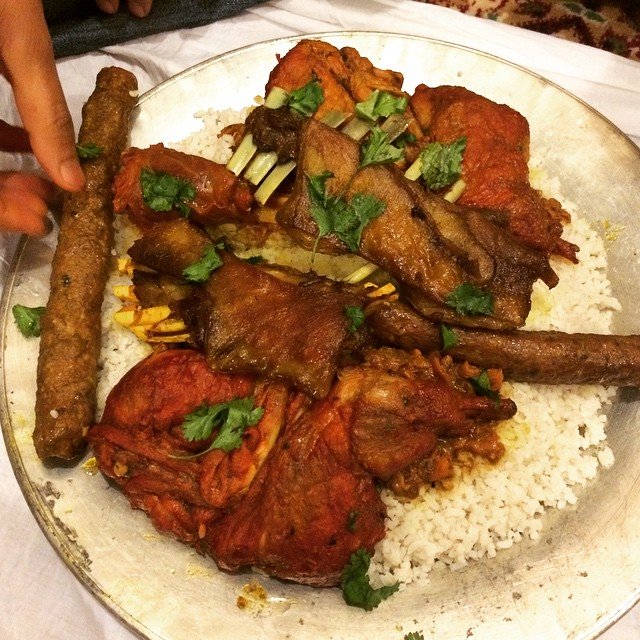Wazwan’s True Colour Lies in Taste, Not Chemicals
By: Javid Amin | 02 October 2025
A Feast at Risk: When Colour Overshadows Tradition
In the bustling kitchens of Srinagar and the festive halls of Anantnag, the age-old aroma of saffron, Kashmiri chillies, and slow-cooked meat is being compromised by a modern obsession: artificial colour.
Wazwan, the multi-course Kashmiri feast revered for centuries, is more than a meal—it is a cultural ceremony, a symbol of unity, and a culinary art form. From the rich crimson of Rogan Josh to the golden sheen of Marchwangan Korma and the delicate brown crust of Tabak Maaz, every dish has a story, a rhythm, and a sensory journey.
But in recent years, chefs, caterers, and street vendors are increasingly turning to synthetic dyes like Tartrazine and Sunset Yellow to produce visually striking dishes. The result? A feast that dazzles the eyes but raises serious health and heritage concerns.
Also Read | Saffron, Spice & Everything Nice: Your Ultimate Guide to Kashmir’s Iconic Dishes & Hidden Gastronomic Gems
The Hidden Danger Behind the Glow
Synthetic food colours are cheap, fast, and visually compelling—but they come at a cost:
-
Digestive issues: frequent consumption can trigger nausea, abdominal discomfort, and irregular bowel movements.
-
Allergic reactions: some individuals develop rashes, hives, or respiratory irritation.
-
Long-term toxicity: studies suggest links between artificial colour intake and liver stress, kidney strain, and potential carcinogenic effects in chronic consumers.
“Artificial colour may look appealing, but its effects accumulate silently,” warns Dr. Farooq Ahmad, a nutritionist in Srinagar. “For families consuming Wazwan several times a year, these additives can be a hidden health hazard.”
The risk is highest among budget caterers and street vendors, who often bypass natural ingredients like saffron, Kashmiri chillies, and traditional slow cooking, opting for chemical shortcuts to save time and cost.
Taste Over Tint: Chefs Lead the Way
In response, Srinagar’s culinary community is quietly reclaiming authenticity. Master chefs across the Valley emphasize flavour, aroma, and texture over artificial vibrancy.
“Wazwan is poetry in meat,” says Chef Tariq from Rajbagh. “Its soul lies in the slow simmer, in layering spices, in patience—not in shortcuts. The colour comes naturally if you respect the ingredients.”
Chefs report that dishes prepared the traditional way are more aromatic, tender, and rich in flavour, even if the visual impact is subtler.
“Artificial colours mask the real story,” adds Chef Shahnawaz from Lal Chowk. “When you taste a Rogan Josh with chemicals, you’re missing centuries of culinary knowledge.”
Also Read | Unlocking the Secrets of Kashmiri Cuisine: The Magic of Dried Cockscomb Flower (Mawal)
Cultural Consequences: Colour vs. Care
Beyond health, experts warn that chemical shortcuts dilute the cultural and emotional value of Wazwan.
Food historian Dr. Shabnam Qadri of Kashmir University explains:
“Wazwan is not just about eating; it’s about storytelling, ritual, and identity. When colour replaces care, we lose the story—the slow-simmered marination, the communal preparation, the ceremonial presentation. Weddings, Eid feasts, and wartav ceremonies lose their soul when visual spectacle overtakes authenticity.”
Local families recount instances where the “eye-catching” red of Rogan Josh failed to deliver the expected depth of aroma or tenderness, leaving elders disappointed and younger generations confused about tradition.
Reform in the Kitchen: Regulatory and Community Action
Recognizing the risks, the Jammu & Kashmir Tourism and Food Safety Department is drafting guidelines to regulate food colour usage in commercial kitchens. The initiative seeks to:
-
Limit synthetic dye use in restaurants, caterers, and street vendors.
-
Encourage chefs to adopt natural colouring methods like saffron, Kashmiri chillies, turmeric, and caramelized onions.
-
Educate the public on the health benefits of authentic Wazwan preparation.
Meanwhile, public campaigns are gaining traction:
-
#TasteNotToxins encourages families and restaurants to prioritize natural ingredients.
-
#WazwanWithoutWounds highlights the connection between heritage preservation and health.
Social media influencers, food bloggers, and health advocates are now actively promoting Wazwan prepared the traditional, chemical-free way, generating awareness among younger chefs and health-conscious families.
Also Read | Kashmiri Dried Mawal: A Natural Coloring Agent
Traditional Techniques that Preserve Both Taste and Health
Chefs and culinary elders outline several methods that naturally enhance Wazwan’s vibrancy without chemicals:
-
Saffron infusion: For the golden-red tones in kormas and rice.
-
Kashmiri chillies: Slowly ground and fried in mustard or sunflower oil to produce rich, natural red hues.
-
Caramelized onions: Slow cooking adds depth and brownish hues to stews and gravies.
-
Ghee finishing: Gives sheen and enhances aroma without relying on colour additives.
-
Marination patience: Long marination allows meat to absorb spices fully, producing natural colour and tenderness.
These techniques, though time-consuming, honour the centuries-old culinary heritage of Kashmir while safeguarding health.
Community Engagement and Youth Participation
Local culinary schools in Srinagar and Anantnag are now teaching students the art of authentic Wazwan, emphasizing taste over tint. Competitions and workshops highlight traditional preparation, natural colour extraction, and the history behind each dish.
Families, too, are becoming more aware. Mothers and grandmothers often insist on slow-cooked, naturally coloured meals for weddings and festivals, passing on wisdom to the next generation.
NGOs have begun public awareness drives, combining nutrition education with cultural storytelling, ensuring that health and heritage go hand-in-hand.
Also Read | Namda: A traditional craft from Kashmir finds new life in the global market
A Broader Message: Food, Health, and Identity
The debate over synthetic colour in Wazwan is not just culinary—it is symbolic of broader societal choices:
-
Choosing shortcuts over patience reflects modern pressures and fast-paced lifestyles.
-
Prioritizing visual spectacle over flavour risks eroding centuries of tradition.
-
Protecting health while preserving cultural identity requires collective awareness, from chefs to consumers.
“Wazwan teaches us patience, respect, and artistry,” Dr. Qadri emphasizes. “When we compromise on these values, we lose more than taste—we lose a part of Kashmir’s soul.”
Final Word: Reclaiming the True Colour of Wazwan
The movement for chemical-free Wazwan is gaining momentum across Kashmir. Chefs, nutritionists, cultural historians, and the public are slowly redefining what a true Wazwan looks and tastes like.
In the words of Chef Tariq:
“If the meat melts in your mouth, if the aroma rises and the spices sing, the colour is already perfect. Wazwan’s beauty has never been in a bottle of dye—it has always been in care, patience, and tradition.”
As #TasteNotToxins and #WazwanWithoutWounds spread through social media and community kitchens, one message is clear: in Kashmir, the true colour of Wazwan lies in taste, not chemicals.




